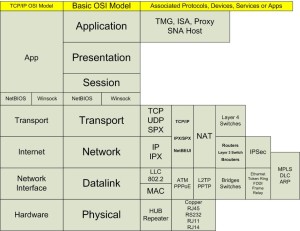Layer 1 is where Prosedium focuses and thrives.
Most IT professional are well aware of the seven-layer OSI model of computer networking architecture. At the foundation of this model is the physical layer which all higher level layers build upon, without this layer modern telecommunications could not exist.
Networking Architecture Model: Layer 1
The following is a visual model that breaks down the layers from the OSI model and maps them to the TCP/IP stack that the internet is built on. It shows some of the most common technologies within those layers so you get a better understanding of the concepts.
To keep things simple you can think of a layer 1 as one that involves a physical communication medium, commonly referred to as bare metal or hardware assets. These mediums act as raw bit transmission carriers in synchronized communications for following types of signals:
- electrical
- electromagnetic (radio)
- optical (light)
- mechanical
Within the semantics of the OSI network architecture, the physical layer translates logical communications requests from layer 2, the data link layer, into hardware-specific operations to affect transmission or reception of signals.
Examples of Layer 1 Hardware Assets
Due to the plethora of available hardware technologies and asset types with widely varying characteristics, this is perhaps the most complex layer in the OSI architecture. The following is a list of the core hardware assets types you would see in typical data centre architectures:
- Server
- SAN
- Routers, switches
- Firewall appliances
- Wireless Access Points and controllers
- Cables: infrastructure, in-cabinet, copper and fibre
- Patch panels
- Power Systems: UPS and PDU
- Racking and cabinet Systems
- Data center rooms
These hardware assets are the foundation of critical business applications in layer 7 that organizations rely on to function. These application include Exchange, ERP, CRM, etc. Any downtime of these hardware assets is an expensive and potentially debilitating event.
Why are Layer 1 services needed?
Poorly managed changes to hardware assets that involve human interaction are the usually the root cause of downtime because of the complexity of this layer. Therefore it is quintessential to have a mature change management discipline on layer 1 if your business is to thrive.
As IT organizations have matured and evolved over the years, performing changes on layer 1 has reduced significantly to the point where there exists minimal or no capability to execute them when needed without incurring a significant increase in downtime risk. It’s becoming a lost art!
A prerequisite to layer 1 change management is a validated and verified asset registry. From what we’ve seen, organizations usually don’t have one which is a common root cause of unexpected headaches.
The services that we provide at Prosedium are focused on derisking layer 1 changes and events such at data centre relocations. For more specifics on the types of services we provide head over to the Services section of our website and check out IT Asset Management and Data Centre Services.
Wikipedia, The Free Encyclopedia, s.v. “Physical Layer,” (accessed February 20, 2016), https://en.wikipedia.org/wiki/Physical_layer

